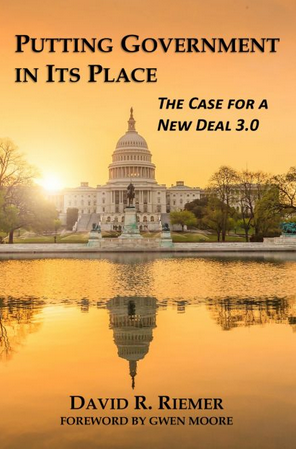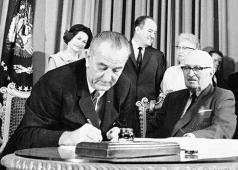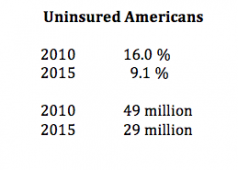The Way Forward on Health
The nation’s dysfunctional health insurance system can also be fixed.
The single most important step we can take to improve the health of the American people is to dramatically reduce unemployment, poverty, and inequality. The work-based policy package proposed here is likely to do more to improve health itself than any reform of the health insurance system itself. Read More ->
Rational Health Insurance
Yet even if improving the economic and other social "determinants" of health is the most powerful way to improve health outcomes, the United States also deserve a rational health insurance system.
We have made enormous progress on the tortuous path. Major milestones marking the way include: the enactment of Medicaid and Medicare in 1965; the creation of the State Children's Health Insurance Program (SCHIP) in 1997; and most recently the passage of the Affordable Care Act (aka Obamacare) in 2010.
But 29 million Americans are still uninsured as of 2017. Health care costs still rising faster than inflation. There remains a long way to go.
The current system would be improved if converted to a single-payer model—that is: Medicare for all. Such a single payer model, however, is likely to face the same difficulty that Medicare has experienced in controlling costs (even though, in recent years, Medicare has seen less difficulty on that front).
While a single payer mechanism like Medicare-for-all would be superior to the status quo, it would also be a second-best solution. A far preferable solution would be to (1) provide all Americans with health insurance; (2) require all health care plans to provide excellent benefits (even better than Medicare's); and (3) use the most basic of market forces--choice, competition, and incentives--to drive out the massive error, waste, and inefficiency that permeate our health care system...and thus lower costs, enhance quality, and achieve far better health outcomes.
Universal Coverage
To begin with, every U.S. resident should of course have health insurance.
Call it a “right” or a “privilege,” health insurance is a necessity. Lacking it opens the door to premature death, avoidable illness, and financial catastrophe. Universal health insurance will save lives, reduce both the frequency and duration of sickness, and protect Americans from bankruptcy and other forms of fiscal stress.
Excellent Benefits
Every health insurance plan should in turn provide comprehensive benefits—paying for necessary medical treatment, hospital care, prescription drugs, and more.
Creating a True Market
We should require the system to include the five features of an effective health insurance market:
- Annual consumer choice among competing high-quality health care plans;
- Price competition based on the single price that everyone can understand and compare: each health care plan's monthly premium per enrollee for the same, excellent, benefits. Even Einstein could not make any sense of the kind of price comparisons that today's system demands, in which we must simultaneously compare premiums, deductibles, co-pays, co-insurance, out-of-pocket maximums, and different benefit levels.
- Objective information for consumers about the comparative quality of the competing health care plans and their provider networks;
- Valid evidence for consumers about the competing plans' health care outcomes, risk-adjusted so that plans are judged on how well they perform with whatever enrollees select them (rather than on the accident of how sick or healthy sicker their enrollees happen to be);
- Powerful and enduring incentives to lower cost, improve quality, and achieve better outcomes.
To get the right incentives into the system, the starting point is for consumers to have a clear and strong incentive to select the lowest-cost health care plan that meets high standards of quality and outcomes. This requires (A) enabling U.S. residents to pay the full premium of the lowest-cost plan without making any out-of-pocket payments, but (B) obliging them to pay out-of-pocket the full difference between the lowest-cost plan's premium and the higher premium charged by any other plan. Structuring price signals in this fashion is the key to enabling the health insurance market to drive down costs and at the same time improve quality of care. Read More ->
This consumer-focused incentive in turn leads to enormous, enduring pressure on all the health care plans themselves (and their provider networks) to achieve their business goals--more enrollment, revenue, and profit--by holding down costs and raising quality and improving outcomes. Health care plans and providers can only do this, once the rules of competition are properly structured, by squeezing out the errors, waste, and inefficiency that still permeate America's health care system. Read More ->
The Path to Reform
One simple policy can achieve all this. All Americans (except those who seek care from the military or VA systems, or who qualify for Medicare) would get a personal Health Insurance Purchasing Account. It would be used to purchase excellent, comprehensive, health insurance coverage--including medical treatment, hospital care, prescription drugs, and more--with uniform and very low cost-sharing. The Account's dollar value would equal the premium bid by the lowest-bidding, high-quality health care plan in the local community. Individuals could enroll in any plan. They could thus choose any doctor. HMOs, PPOs, and fee-for-service plans would all be available. Individuals would augment the dollar value of their Accounts, adding their own funds, if they wanted to pay the extra amount needed to join any health care plan whose premium exceeded the low bid.
Each individual’s Health Insurance Purchasing Account would be personal and permanent. It would not be affected by age (at 65, it would be used to enroll in Medicare). Not would it change due to family circumstances (e.g., marriage, divorce, leaving home), employment status, or income.
With all Americans annually using their Health Insurance Purchasing Accounts to choose the health care plans they most want, and paying extra out-of-pocket only if they really want a more costly plan, the market pressure on health insurance companies and health care providers to lower their costs and improve their quality will be intense and lasting.
It would have been smart for Congress to have enacted this model (folding Medicaid into it) in lieu of Obamacare. Read More ->
Today, it remains the model that should replace Medicaid and Obamacare, funded as an off-budget social insurance program. Read More ->
The Need for Long-Term Care Insurance
Equally urgent is the need to create a comprehensive national program of long-term care insurance.
More Americans than ever are living into old age. The number of "old old" individuals who live 85 years or more--a group that includes the most frail seniors--has risen sharply. Yet Medicaid pays for nursing homes and other types of long-term care only for the poorest, often pressuring seniors to qualify by giving up their savings. Medicare meanwhile offers a very short long-term care benefit
The ultimate solution is a new social insurance program, phased in over time, that will provide seniors in the future with the resources they need to pay for long-term care for as long as required. Read More ->


